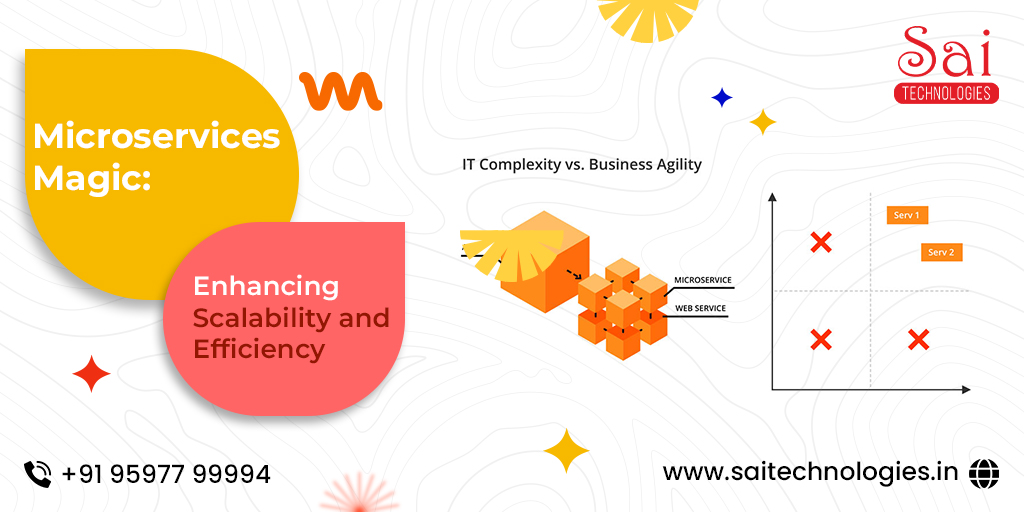Microservices Magic
Enhancing Scalability and Efficiency

Introduction:
In the ever-evolving world of software development, one architectural approach has gained popularity for its ability to increase agility, scale, and efficiency—engineering services. Unlike traditional monolithic architectures, microservices decompose applications into smaller, individually deliverable services that focus on a single business function. In this comprehensive guide, we dive into the world of microservices, exploring their key principles, benefits, challenges, and best practices.
Learn about Microservices:
The core concept of microservices architecture is based on the principle of decomposition. Microservices engineers break applications into small, easily connected services, rather than building large monolithic applications in which all functions are integrated. Each service is responsible for different functions or features and communicates with other services through well-defined APIs.
Key principles of mechanical services:
Decomposition:
Applications are broken down into smaller services, each serving a specific business function. This decomposition allows teams to focus on a single service, streamlining development, testing and maintenance.
Autonomy:
Microservices are designed to be individually deployable and scalable. Changes to one service do not require changes to other services, and changes can be made quickly and easily.
Agility:
Microservices increase efficiency by isolating failures. If one service fails, this does not affect the entire system, because other services can work independently.
Technology Diversity:
Each microservice can be built using a technology stack that suits its needs. This allows teams to choose the right tools and technologies for each service, rather than being limited by a single technology stack.
Scalability:
Microservices support horizontal scalability, allowing each service to be individually scalable as needed. This allows efficient use of resources and optimal performance in different tasks.
Advantages of mechanical services:
Agility:
Microservices can accelerate software development cycles because teams can work independently on individual services. This flexibility allows for rapid expansion and adaptation to different needs.
Scalability:
Microservices support rapid scalability and can allocate resources to meet demand. This ensures optimal performance and responsiveness even under heavy loads.
Flexibility:
Microservices architecture increases efficiency by isolating failures and implementing clear boundaries between services. Failure of one service does not spread to other services, reducing the impact on the entire system.
Technical Diversity:
Microservices allow flexibility in technology selection, allowing teams to choose the tools and frameworks that are appropriate for each service. This encourages innovation and enables the adoption of new technologies.
Better maintainability:
Code libraries are easier to understand, debug, and maintain with smaller, more focused services. Updates and bug fixes can be applied to a single service without affecting the entire application, making maintenance easier.
Microservices challenges:
Distributed complexity:
Microservices add complexity to distributed systems, requiring robust service discovery, communication, and coordination solutions.
Data Management:
Managing data consistency and reliability between distributed services can be challenging. Solutions such as event detection and special transactions are often used to overcome these challenges.
Service coordination:
Coordination of interactions between machine services, especially in concurrent and event-based architectures, must be carefully designed and implemented to ensure consistency and reliability.
Performance:
Managing multiple machine services increases performance, including deployment, monitoring, and scaling. Automation and DevOps processes are important to reduce these additional costs.
Microservices best practices:
Domain design:
Apply domain design principles to define clear boundaries between services based on business capabilities.
API Design:
Follow RESTful or GraphQL principles to design powerful and intelligent APIs for communication between services.
Scalability:
Use virtualization technologies like Docker to package and deploy microservices across multiple environments.
Orchestration:
Leverage an orchestration platform such as Kubernetes to automate the deployment, prototyping, and management of machine services. Continuous Integration / Continuous Delivery (CI / CD): Set up CI / CD pipelines to automate testing, deployment, and release of changes to ensure fast and reliable delivery of new features and updates .
Monitoring and Inspection:
Implement a monitoring solution with comprehensive visibility to understand the performance, health, and behavior of your machine services.
Conclusion:
Microservices architecture represents a paradigm shift in software development, enabling teams to build scalable, robust, and agile systems. By decomposing applications into smaller, individually deliverable services, service engineering enables faster, simpler, and more robust development cycles. However, implementing microservices also brings challenges such as deployment complexity and overhead, which must be managed carefully. By following best practices and using the right technologies, organizations can harness the full potential of automated services and drive innovation in the digital age.


